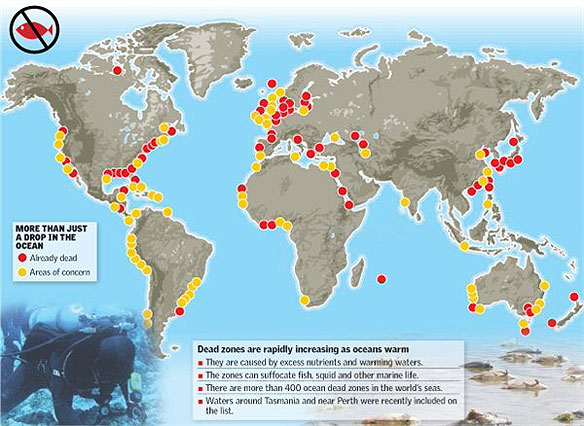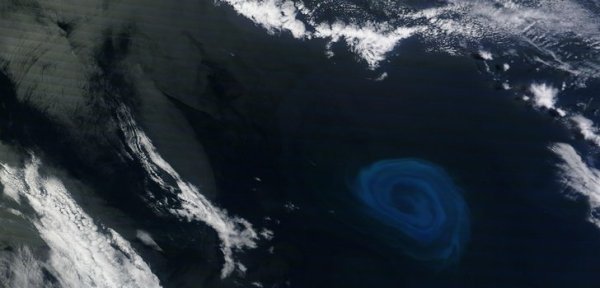Red Tide. It’s what happens when massive algae blooms cover vast regions of ocean.
The biological density of the blooms is so great that they can paint the waters affected a shade of brown or red. A bloody color indicative of clouds of dangerous microbes just beneath the surface. And today, a massive Red Tide — perhaps the largest ever recorded — now stretches from California to Alaska along a vast stretch of the North American West Coast already reeling under the ongoing and dangerous impact of a massive ocean heating event that researchers have called ‘The Blob.’
(A Red Tide can paint the ocean in bloody shades as seen in the image above. It’s also bad news for many marine species — first due to production of deadly biotoxins and second due to its ability to rob ocean waters of oxygen as the bloom dies off and decays. Image source: Wind’s Sustainability Blog.)
A Red Tide has numerous impacts to both marine life and human industry. Microbes within the tide produce biotoxins that are deadly to marine species. Domoic acid, PSP and DSP are all toxins that have been identified during the current Red Tide event. The toxins primarily affect fish and marine mammals — risking mass fish and dolphin, sea lion, seal, otter, and whale deaths during widespread blooms. The toxins concentrate as they move up the food chain, making them most dangerous to top predators. Primary effects of the most lethal toxins are convulsions and paralysis. Other toxins cause nausea, cramps and diarrhea.
Human beings are also at risk and for this reason crab and shellfish fisheries all up and down the US West Coast are being closed. Impacts are so widespread marine ecologists like Vera Trainer, manager of the Marine Microbes and Toxins Programs at the Northwest Fisheries Science Center in Seattle, are calling the event unpredented:
“The fact that we’re seeing multiple toxins at the same time, we’re seeing high levels of domoic acid, and we’re seeing a coastwide bloom — those are indications that this is unprecedented.”
Global Warming, Hot Blob — Prime Suspects
Scientists currently suspect extreme Northeastern Pacific Ocean heat led to the sudden appearance of Red Tide this week — a combination of warm and nutrient rich waters are well known to be the key ingredients for Red Tide formation. Ingredients that are increasingly prevalent due to human fossil fuel burning. Ingredients that are increasingly evident in the Northeastern Pacific. In short the burning of fossil fuels both warms the atmosphere and ocean even as it seeds the surface water with nitrogen. The warm water is a preferred environment for the microbes that form the Red Tide and the nitrogen — both as a constant rain from the sky due to fossil fuel emission and as effluent from streams due to farm runoff — essentially fertilizes the bloom.
It is for these reasons that many scientists suspect the hot Blob of water in the Northeastern Pacific has played a role in the formation of the current unprecedented Red Tide.
(The Northeastern Pacific hot Blob now features a dangerous Red Tide — perhaps the largest and most toxin laden Red Tide ever seen. Image source: Earth Nullschool.)
Warming the world ocean through human carbon emissions is thus a very dangerous consequence. Now, more and more regions are featuring hot zones that are increasingly deadly to sea life. This region of the Northeast Pacific in particular has seen a number of instances of mass ocean creature death due to impacts associated with warming waters. The recent Red Tide being the last of a long chain including a mass starfish die-off, fish kills, bird kills, and marine mammal deaths and disruption — including a winter and spring emergence of crowds of starving sea lion pups along California beaches.
Next Step — Anoxia, Possible Hydrogen Sulfide Issue
This particular Red Tide is still in its early stages. It could last for weeks. But as it reaches its last days, the mass production of microbial life will rob the ocean surface of the nutrients necessary to sustain it. As this happens, the microbes will experience a sudden die-off. The mass of dead microbes will then sink and decay. This decay will further rob already de-oxygenated waters, particularly off Washington and Seattle, of still more oxygen. So the final act of this particular Red Tide will be to make a bad ocean water oxygen situation in many of the affected regions even worse (in the worst case potentially setting some zones up for an ugly deep water hydrogen sulfide production).
Links:
Toxic Algae Bloom May be the Largest Ever
Huge Bloom of Toxic Algae Hits US West Coast
Awakening the Horrors of the Ancient Hothouse — Hydrogen Sulfide in the World’s Warming Oceans
Hat Tip to Andy in San Diego






















